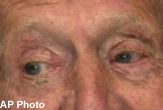Old People See Big Picture Better

One of the more frustrating things about getting old is growing slower. But a new study finds old people are quicker at one important task: Seeing the big picture.
Subjects looked at bars on a computer screen that appeared and moved either left or right. When the bars were small or varying shades of gray, young people processed the scene more quickly. But when the bars were large and had high contrast -- black and white -- older people consistently outperformed the younger ones by about 30 percent.
The results partly involve differences in vision. But scientists see a deeper meaning.
Young brains are able to find things amid clutter by tuning out noise, the researchers contend. As our brains age, they lose the ability to inhibit information processing in this way, so they can't tune things out so easily. The young brain, when presented with a simple, high-contrast picture, is still in tune-things-out mode and, because there is no hidden object to find, is slower at seeing the big picture.
Here's how the difference might play out when watching a soccer game:
"It might be more difficult for older observers to follow the movements of an individual, but they might be able to better see where the team as a whole is going," explained study co-leader Allison Sekuler of McMaster University in Canada.
"In general older people are not better on most tasks," Sekuler told LiveScience. "But they're better at grasping the big picture instead of focusing in on details."
Sign up for the Live Science daily newsletter now
Get the world’s most fascinating discoveries delivered straight to your inbox.
The study, detailed in the Feb. 3 issue of the journal Neuron, provides insight into how the brain changes with age. Specifically, it reveals something about chemical messengers called neurotransmitters, which are like old-fashioned operators at the phone company, in this case directing communications between brain cells.
"As we get older, it becomes harder to concentrate on one thing and ignore everything else," says McMaster researcher Patrick Bennett, the other study leader. "It takes more effort to tune out distractions. We've seen it in cognition and speech studies, and now we see it in vision. Although we don't know if those are all linked, we think the visual effect is due to changes in the effectiveness of inhibitory neurotransmitters in the brain."
The initial study involved eight young people and eight old people. A follow-up test was done with 54 people to verify the results.
In a separate paper analyzing the study, vision specialists Duje Tadin and Randolph Blake from Vanderbilt University caution that "a large number of outstanding questions" must still be answered to figure out exactly why older people did well at this task. But the results are encouraging, they say.
"We can all hope that this line of research will eventually yield treatment options for some of the problems that await us in old age," Tadin and Blake write.
Sekuler said follow-up studies are being designed to find out how drugs might affect the neurotransmitters. The question, she said: "Can we turn old brains into young ones and young brains into old ones?"
Robert is an independent health and science journalist and writer based in Phoenix, Arizona. He is a former editor-in-chief of Live Science with over 20 years of experience as a reporter and editor. He has worked on websites such as Space.com and Tom's Guide, and is a contributor on Medium, covering how we age and how to optimize the mind and body through time. He has a journalism degree from Humboldt State University in California.











